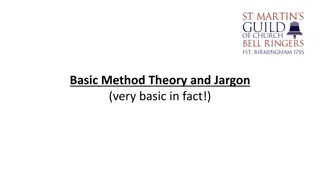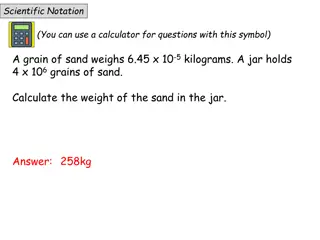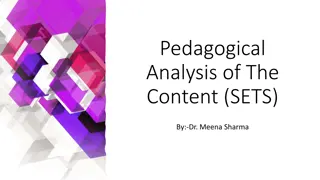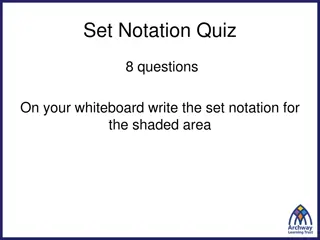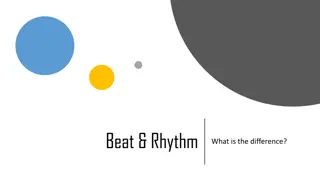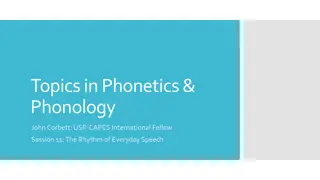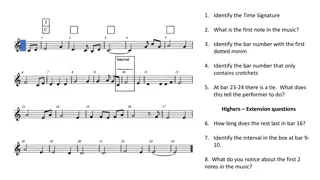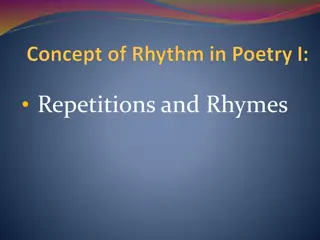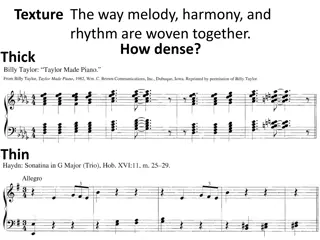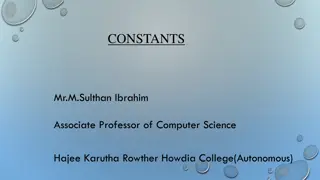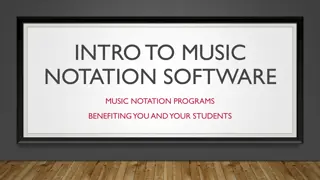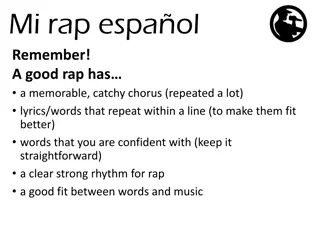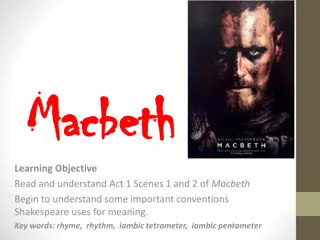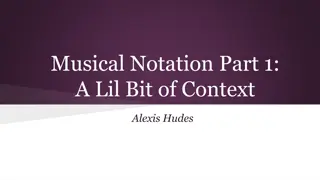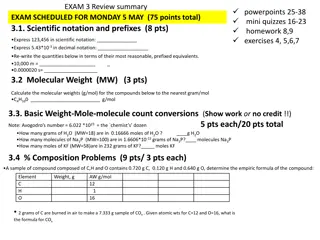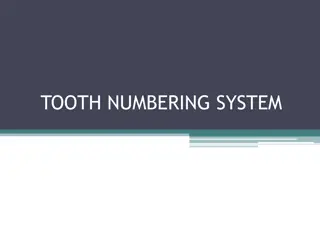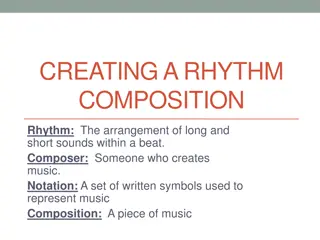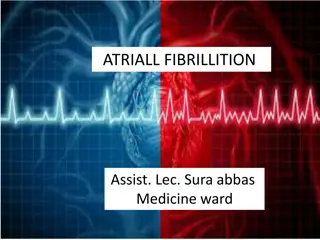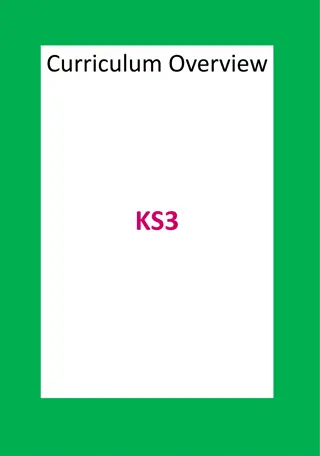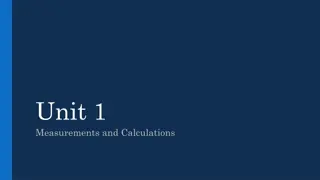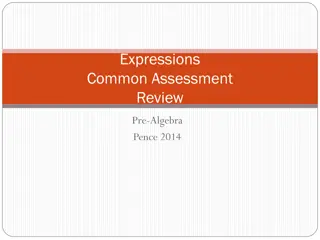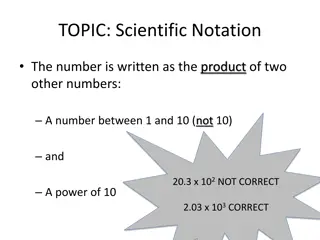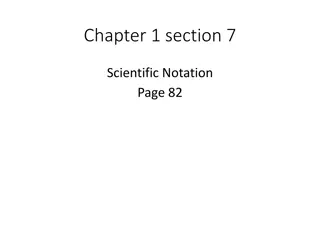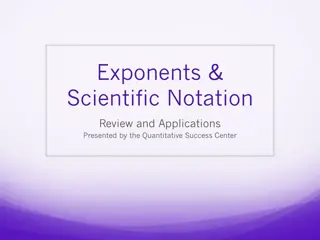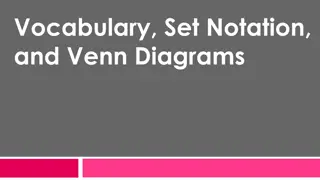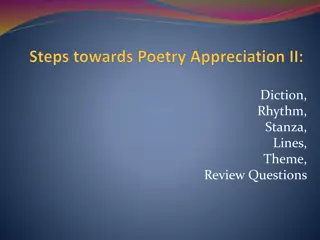Understanding the Importance of Coordinative Abilities in Sports
Coordinative ability is crucial in sports for performing movements with precision and efficiency. It involves the body's capability to change direction swiftly, ensuring good balance during actions. This ability comprises various types such as orientation, reaction, rhythm, balance, adaptation, coup
0 views • 11 slides
Introduction to Basic Music Theory Concepts and Notation
Delve into the fundamental elements of music theory, exploring notation, scales, and chord progressions through visual representations. Learn how to read and interpret musical symbols, paving the way for a deeper understanding of music composition.
2 views • 13 slides
Mathematics Practice Problems - Fractions, Percentages, Scientific Notation, and Expanding Brackets
Practice various mathematics topics such as fractions, percentages, scientific notation, and expanding brackets with sample problems and solutions.
0 views • 66 slides
Pedagogical Analysis of Sets in Mathematics: Key Concepts and Teaching Strategies
Explore the pedagogical analysis of SETS by Dr. Meena Sharma, focusing on major concepts like the meaning of SET, SET notation, classification of SETS, and fundamental operations. Understand minor topics such as examples of sets, SET notation methods, and types of SETS. Objectives include defining S
0 views • 8 slides
Understanding Enemark-Feltham Notation in Iron-Nitrosyl Complexes
Iron-Nitrosyl complexes are redox non-innocent, with NO exhibiting multiple redox states. Enemark-Feltham Notation helps in determining metal-ligand interactions and oxidation states. Detailed information on NO ligands, bonding characteristics, and methods for analyzing iron-NO systems are discussed
0 views • 6 slides
Math Set Notations and Probability Practice
Practice set notation and probability with quizzes on set notation, Venn diagrams, and probability calculations based on survey results. Improve your math skills through visual exercises and calculations.
0 views • 19 slides
Principles and Elements of Interior Design Explained
Explore the fundamental principles of interior design, including proportion, rhythm, emphasis, balance, scale, and harmony. Delve into the significance of scale, proportion, rhythm, emphasis, balance, and harmony in creating cohesive and visually appealing spaces. Discover how design elements like s
0 views • 18 slides
Composer Spotlight: Jennifer Higdon - Music and Creativity
Jennifer Higdon, a renowned composer known for her contemporary orchestral music, overcame a late start to become a major figure in the music world. From winning prestigious awards to teaching young musicians, her contributions are significant. Explore her life, achievements, featured work "City Sca
0 views • 6 slides
Understanding the Difference Between Beat and Rhythm in Music
Beat and rhythm are essential elements in music. The beat provides the steady pulse, akin to your heartbeat, while rhythm encompasses the sounds and silences within the music. Learn how to distinguish between them and how they interact within various musical compositions through engaging rhymes and
0 views • 10 slides
Understanding IP Addressing and Conversion from Binary to Decimal
Learn about IP addressing, including binary notation, dotted-decimal notation, and the process of converting binary numbers to decimal. Explore the unique features of IP addresses and the steps involved in converting binary to decimal systematically.
3 views • 47 slides
Understanding English Rhythm and Stress Patterns in Speech
Delve into the nuances of English rhythm and stress patterns in speech with a focus on word stress, phrase stress, and the principle of eurhythmy. Explore how stress is influenced by volume, pitch, and duration of syllables in monosyllabic, disyllabic, trisyllabic, and polysyllabic words, with empha
0 views • 25 slides
Music Notation Analysis Questions and Answers
This content provides a series of music notation analysis questions with corresponding images for practice and learning purposes. The questions cover topics such as identifying time signatures, notes, rests, intervals, keys, and specific bars with certain musical elements like ties, dotted minim, cr
0 views • 12 slides
Finding Our Rhythm: Trans & Queer Music Resistance Workshop
Explore the transformative power of music in resistance movements led by trans and queer individuals. Join a youth-driven session to honor LGBTQ+ performers, find rhythm in community, and engage in discussions around identity and resistance. Through music, discover a universal language that expresse
0 views • 26 slides
Understanding Repetitions, Rhymes, and Rhythm in Poetry
Explore the significance of repetitions, various rhyming patterns, and the essence of rhythm in poetry through examples of phonetic rhymes, couplets, and traditional Yoruba poems. Delve into how these literary devices enhance the poetic structure and emphasize the meaning of poems.
0 views • 12 slides
Exploring Textures in Music: Melody, Harmony, and Rhythm
Dive into the intricacies of musical textures where melody, harmony, and rhythm intertwine in various ways such as monophonic, polyphonic, homophonic, and chordal textures defining the density and range of musical compositions.
0 views • 31 slides
Exam Style Music Revision: Tonality, Rhythm, Speed, and More
Dive into exam-style music revision covering topics such as tonality, key signatures, rhythm/tempo, speed changes, and various musical elements. From major/minor tonality to dynamic markings and instrument descriptions, enhance your music knowledge through this comprehensive guide.
0 views • 41 slides
Understanding Different Types of Constants in Programming
Constants in programming are fixed values that do not change during program execution. They include character, numerical, and string constants. Integer constants can be decimal, octal, or hexadecimal. This article explains each type of constant with examples of decimal, octal, and hexadecimal intege
0 views • 22 slides
EEG-Based BCI System for 2-D Cursor Control Combining Mu/Beta Rhythm and P300 Potential
Brain-computer interfaces (BCIs) offer a pathway to translate brain activities into computer control signals. This paper presents a novel approach for 2-D cursor control using EEG signals, combining the Mu/Beta rhythm and P300 potential. By simultaneously detecting two brain signals, P300 and motor
0 views • 27 slides
Explore the Benefits of Music Notation Software for Educators and Students
Discover the advantages of using music notation software in education, from enhancing creativity and exploration to facilitating composition and arrangement tasks. Learn about popular programs like Musescore, Sibelius, and GarageBand, and empower students to write music for various genres and purpos
0 views • 11 slides
Fun Rap Writing Activity for Creativity & Rhythm Development
Engage in a creative rap writing activity to enhance rhythm and expression. Craft a rap about yourself, your interests, and dislikes. Join forces with others to create a catchy chorus. Express your thoughts on the presentation and rhythm as you delve into this enjoyable and imaginative exercise.
0 views • 4 slides
Understanding Shakespeare's Conventions in Macbeth Act 1 Scenes 1 and 2
Explore the importance of rhyme, rhythm, iambic tetrameter, and iambic pentameter in Act 1 Scenes 1 and 2 of Macbeth. Dive into the conventions Shakespeare uses for conveying meaning, including the use of rhyme in verse, rhyming couplets, and the significance of rhythm in the witches' opening scene.
0 views • 16 slides
Evolution of Musical Notation Systems and Contexts
Explore the diverse world of musical notation systems, from Eastern to Western traditions, spanning Babylonian notations, Guido d'Arezzo's contributions, Gregorian chants, and modern-day tempo measures. Uncover the rich history and nuances of musical expression through various scales, staves, orname
0 views • 12 slides
Chemistry Exam Review: Topics in Scientific Notation, Molecular Weight, Stoichiometry, and Limiting Yield
Explore key concepts in chemistry, including scientific notation, molecular weight calculations, reaction balancing, stoichiometry, and limiting yield problems. Prepare for an upcoming exam by practicing various problems and conversions related to these topics, such as expressing numbers in scientif
0 views • 4 slides
Understanding Tooth Numbering Systems in Dentistry
Dental professionals use various tooth numbering systems to identify and record teeth in the mouth. The three main systems are Universal Notation, Zsigmondy/Palmer Notation, and Federation Dentaire Internationale (FDI). Universal Notation utilizes letters for primary teeth and numbers for permanent
0 views • 19 slides
Understanding Big-Oh Notation in Time Complexity Analysis
Big-Oh notation in algorithm analysis signifies how the runtime of an algorithm grows in relation to the input size. It abstractly characterizes the worst-case time complexity, disregarding constants and lower-order terms. The concept of Big-Oh, along with Big-Omega and Big-Theta, helps in comparing
0 views • 18 slides
Exploring Rhythm Composition in Music Education
Dive into the world of rhythm composition with key elements such as notation, time signatures, and rhythm vocabulary. Learn how to create engaging rhythm compositions, practice with partners, and develop essential music math skills. Let's compose together and enhance our musical creativity!
0 views • 12 slides
Understanding the Control of Breathing and Respiratory Rhythm
The content delves into the intricacies of the control of breathing, emphasizing the role of the medulla oblongata in regulating respiratory activity. It explores factors modifying breathing patterns, respiratory consequences of changing PO2, PCO2, and pH, and the functions of central and peripheral
0 views • 16 slides
Atrial Fibrillation Overview: Symptoms, Treatment, and Management
Heart Failure (HF) is increasingly recognized as a cause of Atrial Fibrillation (AF). The goals of individualized therapy for AF include ventricular rate control, restoration of sinus rhythm, maintenance of sinus rhythm, and prevention of stroke. Hemodynamically unstable AF requires emergent convers
0 views • 29 slides
Music Notation and Interpretation in KS3 Curriculum
Explore music notation in KS3 Music curriculum, focusing on reading and writing notes from E up to F on the treble clef. Understand various forms of notation such as graphic scores and enhance your musical literacy skills throughout the academic year.
0 views • 89 slides
Understanding Scientific Notation and SI Measurement Basics
Explore scientific notation as a method for expressing large and small numbers efficiently in mathematical calculations. Practice converting numbers into scientific notation and learn the rules for multiplication, division, addition, and subtraction in this format. Additionally, discover the benefit
0 views • 41 slides
Activate Your Brain with Rhythm and Movement for Enhanced Learning
Engage both sides of the brain by incorporating rhythm and movement into education with STEAM activities. Enhance memory retention, reading readiness, and critical thinking skills through various exercises like brain dance, rhythm activators, and tiptoe feet. Discover the benefits of maintaining a s
0 views • 17 slides
Pre-Algebra Review: Expressions and Exponents
This pre-algebra review covers topics such as evaluating expressions, working with exponents, using scientific notation, and standard form notation. Examples and answers help reinforce understanding of fundamental algebraic concepts.
0 views • 29 slides
Understanding Scientific Notation in Mathematics and Chemistry
Scientific notation is an essential concept for representing very large or very small numbers efficiently. It simplifies numbers by expressing them as a coefficient multiplied by a power of 10. This summary covers the basics of scientific notation, from converting numbers to and from scientific nota
0 views • 55 slides
Understanding Molar Mass and Avogadro's Number in Chemistry
Explore the concept of molar mass and Avogadro's number in chemistry through lessons on translating numbers into scientific notation, understanding moles, and finding molar mass on the periodic table. Discuss the relationship between mass and moles, differentiate between different quantities of a su
1 views • 11 slides
Understanding Exponents: Simplifying Expressions and Scientific Notation
Explore the concept of exponents, learn how to simplify expressions with negative exponents, and delve into scientific notation for efficiently representing large numbers. Discover the basics of exponents, operations involving exponents, and the application of scientific notation in various discipli
0 views • 8 slides
Understanding Scientific Notation: Converting, Multiplying, Dividing & More
Scientific notation is a way to express large or small numbers efficiently. Learn how to convert numbers to and from scientific notation, multiply and divide in scientific notation, and ensure proper formatting. Understand the rules for exponents and make calculations easier with these simple steps.
0 views • 8 slides
Understanding Scientific Notation and Conversions
Scientific notation is a useful way to express very large or very small numbers in a concise form. This chapter discusses how to convert numbers between scientific notation and decimal notation, providing examples and explanations for better understanding.
0 views • 18 slides
Understanding Exponents and Scientific Notation
Exponents are powers to which bases are raised, allowing for efficient representation and calculation of numbers. This review covers the basics of exponents, rules, laws, and practical applications. Scientific notation offers a method to express very large or small numbers using powers of 10. Learn
0 views • 13 slides
Understanding Set Notation and Probability in Visuals
Explore the concepts of vocabulary, set notation, Venn diagrams, probability, experiments, outcomes, sample space, events, unions, intersections, complements, and set notation through visual aids and clear explanations. Learn about subsets, empty sets, and more in this comprehensive resource from Wa
0 views • 24 slides
Exploring Elements of Poetry: Diction, Rhythm, Stanza, Lines, Theme
Delve into the nuances of poetry with a focus on diction, rhythm, stanza formation, line arrangement, and thematic exploration. Understand how these elements contribute to the mood and meaning of a poem through insightful analysis and review questions.
0 views • 13 slides

